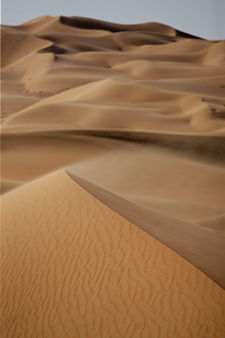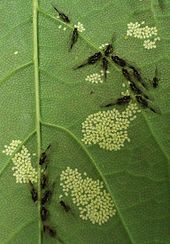Patterns in nature
 |
| Patterns in nature |
kinds of kinds of geometric motif, flora, fauna - Patterns in nature are visible regularities of form found in the natural world. These patterns recur in different contexts and can sometimes be modelled mathematically. Natural patterns include symmetries, trees, spirals, meanders, waves, foams, tessellations, cracks and stripes.[1] Early Greek philosophers studied pattern, with Plato, Pythagoras and Empedocles attempting to explain order in nature. The modern understanding of visible patterns developed gradually over time.
In the 19th century, Belgian physicist Joseph Plateau examined soap films, leading him to formulate the concept of a minimal surface. German biologist and artist Ernst Haeckel painted hundreds of marine organisms to emphasise their symmetry. Scottish biologist D'Arcy Thompson pioneered the study of growth patterns in both plants and animals, showing that simple equations could explain spiral growth. In the 20th century, British mathematician Alan Turing predicted mechanisms of morphogenesis which give rise to patterns of spots and stripes. Hungarian biologist Aristid Lindenmayer and French American mathematician Benoît Mandelbrot showed how the mathematics of fractals could create plant growth patterns.
Mathematics, physics and chemistry can explain patterns in nature at different levels. Patterns in living things are explained by the biological processes of natural selection and sexual selection. Studies of pattern formation make use of computer models to simulate a wide range of patterns.

History

Fibonacci patterns occur widely in plant structures including this cone of Queen sago, Cycas circinalis

Early Greek philosophers attempted to explain order in nature, anticipating modern concepts. Plato (c 427 – c 347 BC) — looking only at his work on natural patterns — argued for the existence of universals. He considered these to consist of ideal forms (εἶδος eidos: "form") of which physical objects are never more than imperfect copies. Thus, a flower may be roughly circular, but it is never a perfect mathematical circle.[2] Pythagoras explained patterns in nature like the harmonies of music as arising from number, which he took to be the basic constituent of existence.[3] Empedocles to an extent anticipated Darwin's evolutionary explanation for the structures of organisms.[4]
In 1202, Leonardo Fibonacci (c 1170 – c 1250) introduced the Fibonacci number sequence to the western world with his book Liber Abaci.[5] Fibonacci gave an (unrealistic) biological example, on the growth in numbers of a theoretical rabbit population.[6] In 1917, D'Arcy Wentworth Thompson (1860–1948) published his book On Growth and Form. His description of phyllotaxis and the Fibonacci sequence, the mathematical relationships in the spiral growth patterns of plants, is classic. He showed that simple equations could describe all the apparently complex spiral growth patterns of animal horns and mollusc shells.[7]
The Belgian physicist Joseph Plateau (1801–1883) formulated the mathematical problem of the existence of a minimal surface with a given boundary, which is now named after him. He studied soap films intensively, formulating Plateau's laws which describe the structures formed by films in foams.[8]
The German psychologist Adolf Zeising (1810–1876) claimed that the golden ratio was expressed in the arrangement of plant parts, in the skeletons of animals and the branching patterns of their veins and nerves, as well as in the geometry of crystals.[9][10][11]
Ernst Haeckel (1834–1919) painted beautiful illustrations of marine organisms, in particular Radiolaria, emphasising their symmetry to support his faux-Darwinian theories of evolution.[12]
The American photographer Wilson Bentley (1865–1931) took the first micrograph of a snowflake in 1885.[13]

D'Arcy Thompson pioneered the study of growth and form in his 1917 book
In 1952, Alan Turing (1912–1954), better known for his work on computing and codebreaking, wrote The Chemical Basis of Morphogenesis, an analysis of the mechanisms that would be needed to create patterns in living organisms, in the process called morphogenesis.[14] He predicted oscillating chemical reactions, in particular the Belousov–Zhabotinsky reaction. These activator-inhibitor mechanisms can, Turing suggested, generate patterns of stripes and spots in animals, and contribute to the spiral patterns seen in plant phyllotaxis.[15]
In 1968, the Hungarian theoretical biologist Aristid Lindenmayer (1925–1989) developed the L-system, a formal grammar which can be used to model plant growth patterns in the style of fractals.[16] L-systems have an alphabet of symbols that can be combined using production rules to build larger strings of symbols, and a mechanism for translating the generated strings into geometric structures. In 1975, after centuries of slow development of the mathematics of patterns by Gottfried Leibniz, Georg Cantor, Helge von Koch, Wacław Sierpiński and others, Benoît Mandelbrot wrote a famous paper, How Long Is the Coast of Britain? Statistical Self-Similarity and Fractional Dimension, crystallising mathematical thought into the concept of the fractal.[17]
Causes
Living things like orchids, hummingbirds, and the peacock's tail have abstract designs with a beauty of form, pattern and colour that artists struggle to match.[18] The beauty that people perceive in nature has causes at different levels, notably in the mathematics that governs what patterns can physically form, and among living things in the effects of natural selection, that govern how patterns evolve.[19]
Mathematics seeks to discover and explain abstract patterns or regularities of all kinds.[20][21] Visual patterns in nature find explanations in chaos theory, fractals, logarithmic spirals, topology and other mathematical patterns. For example, L-systems form convincing models of different patterns of tree growth.[16]
The growth patterns of certain trees resemble these Lindenmayer system fractals.

The laws of physics apply the abstractions of mathematics to the real world, often as if it were perfect. For example, a crystal is perfect when it has no structural defects such as dislocations and is fully symmetric. Exact mathematical perfection can only approximate real objects.[22] Visible patterns in nature are governed by physical laws; for example, meanders can be explained using fluid dynamics.
In biology, natural selection can cause the development of patterns in living things for several reasons, including camouflage,[23] sexual selection,[23] and different kinds of signalling, including mimicry[24] and cleaning symbiosis.[25] In plants, the shapes, colours, and patterns of flowers like the lily have evolved to optimise insect pollination (other plants may be pollinated by wind, birds, or bats). European honey bees and other pollinating insects are attracted to flowers by a radial pattern of colours and stripes (some visible only in ultraviolet light) that serve as nectar guides that can be seen at a distance; by scent; and by rewards of sugar-rich nectar and edible pollen
Types of pattern
SymmetryFurther information: Symmetry in biology, Floral symmetry and Crystal symmetry
Symmetry is pervasive in living things. Animals mainly have bilateral or mirror symmetry, as do the leaves of plants and some flowers such as orchids.[27] Plants often have radial or rotational symmetry, as do many flowers and some groups of animals such as sea anemones. Fivefold symmetry is found in the echinoderms, the group that includes starfish, sea urchins, and sea lilies.[28]
Among non-living things, snowflakes have striking sixfold symmetry: each flake is unique, its structure forming a record of the varying conditions during its crystallisation, with nearly the same pattern of growth on each of its six arms.[29] Crystals in general have a variety of symmetries and crystal habits; they can be cubic or octahedral, but true crystals cannot have fivefold symmetry (unlike quasicrystals).[30] Rotational symmetry is found at different scales among non-living things including the crown-shaped splash pattern formed when a drop falls into a pond,[31] and both the spheroidal shape and rings of a planet like Saturn.[32]
Symmetry has a variety of causes. Radial symmetry suits organisms like sea anemones whose adults do not move: food and threats may arrive from any direction. But animals that move in one direction necessarily have upper and lower sides, head and tail ends, and therefore a left and a right. The head becomes specialised with a mouth and sense organs (cephalisation), and the body becomes bilaterally symmetric (though internal organs need not be).[33] More puzzling is the reason for the fivefold (pentaradiate) symmetry of the echinoderms. Early echinoderms were bilaterally symmetrical, as their larvae still are. Sumrall and Wray argue that the loss of the old symmetry had both developmental and ecological causes.[34]
With the information we provide about kinds of kinds of geometric motif, flora, fauna
, We hope you can be helped and hopefully set a precedent with you . Or also you can see our other references are also others which are not less good about Best Kebaya Search in Jakarta
, So and we thank you for visiting.
open tutorial sew : https://en.wikipedia.org/wiki/Patterns_in_nature




0 komentar:
Post a Comment